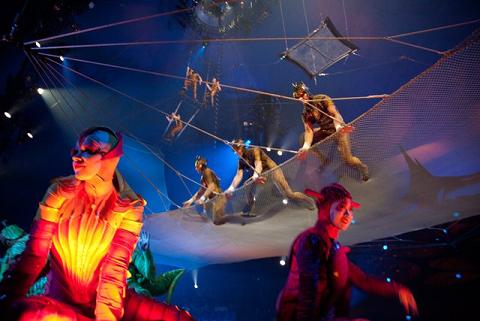I had the opportunity to watch a dress rehearsal of Cirque du Soleil’s new production Amaluna, which opened in Toronto on September 6 and will play till November 4. Amaluna (“Mother Moon”) was directed by Diane Paulus, the artistic director of Harvard University’s American Repertory Theater. The storyline is informed by a female-centric interpretation of Shakespeare’s Tempest with characters such as an island sorceress named Prospera, her daughter Miranda, her eventual lover Romeo, his fellow crew of castaways and a jealous lizard-like creature called Cali. The production has all of the usual qualities of past performances by the “solar circus”: astonishing acrobatics, glittering costumes, hypnotic sets, a narrative that cuts across social and mythological realms, and a set of culturally diverse performances that occasionally border on orientalism.
The world’s most imaginative circus troupe was founded by two street performers — Guy Laliberté and Gilles St. Croix — in Baie St.Paul, Quebec in 1984. The ensemble’s first years were marked by indebtedness and popular indifference. Eventually, of course, the concept struck gold, rewarding the project with critical acclaim and Laliberté with a level of prosperity that has allowed him to purchase, among other things, seven homes, a boat, an island, and a $35-million trip in 2009 on a space shuttle that orbits the Earth.
In light of its unprecedented commercial success and influence, one has to ask: what is the broader social significance of Cirque du Soleil? Cirque’s implicit conception of its art appears to contradict the ideals of many 20th century progressives. Over the past hundred years, activists hoped that artistic expression would unleash the imagination, increase the public’s sensitivity to human suffering, and lead to an increase in political activism. One could argue that Cirque does not increase our compassion for human suffering — in fact, quite the opposite — it demonstrates the astounding possibilities available to humans without mentioning the economic, cultural and political obstacles to their achievement. At some point in their careers, Laliberté and his collaborators may have realized that a family-friendly technically dazzling circus, which loosely tells a tale, in which good defeats bad — and bad is not so bad — is more important than political commitment. In this case, the awe and profits produced by Cirque’s technique overshadows the possibility of producing socially relevant art.
Another conception of aesthetics suggests a different interpretation of Cirque du Soleil: artistic representation allows us to better understand the freedom made available to us in our particular era. The philosophy and religious practices of an epoch do the same but art is distinct from these others, because it does not articulate our culture’s self-understanding via theories, or the feelings inspired by spiritual icons, but through things that have been explicitly constructed for greater self-understanding. Various artistic objects, whether made from metal, sound, colour, or the performance of human bodies, make freedom apparent to the spectators. Cirque’s joyful performances break up the monolithic, patterned forms of intellectual, emotional and physical experience that we have been trained to assume. The troupe presents us with the most culturally plural and dynamic form of popular creative expression that has yet been demonstrated in our age. The imperative guiding Cirque’s art lies not in its desire to ornament our world, replicate it, or jolt us out of apathy, but to enable us to fully experience, through our senses, our essential imaginative freedom: this freedom may be the precondition for any type of social innovation.
Cirque du Soleil’s work does indirectly present some political benefit: the organization has put a sum equivalent to 1 per cent of the company’s gross revenue into their social and cultural action programs as well as into the One Drop Foundation. One Drop is a charitable organization that — in addition to educational activities — works in co-operation with Oxfam and others, to develop access-to-water and sanitation projects in countries where availability is lacking.
One hopes that Guy Laliberté’s decision to support the cause of global water access is not the end but the beginning of even greater social commitment from Cirque du Soleil. While lack of access to clean water is one of our most pressing dilemmas, the deeper problem that underpins it is political illiteracy. The billionaire Laliberté and his inspiring troupe could continue to contribute to the project of building another world by exploring ways of addressing that core challenge.
Thomas Ponniah was a Lecturer on Social Studies and Assistant Director of Studies at Harvard University from 2003-2011. He remains an affiliate of Harvard’s David Rockefeller Center for Latin American Studies and an Associate of the Department of African and African-American Studies.
Photo: Ed Schipul
What’s Harper up to? Award-winning journalist Karl Nerenberg keeps you in the know. Donate to support his efforts today.




